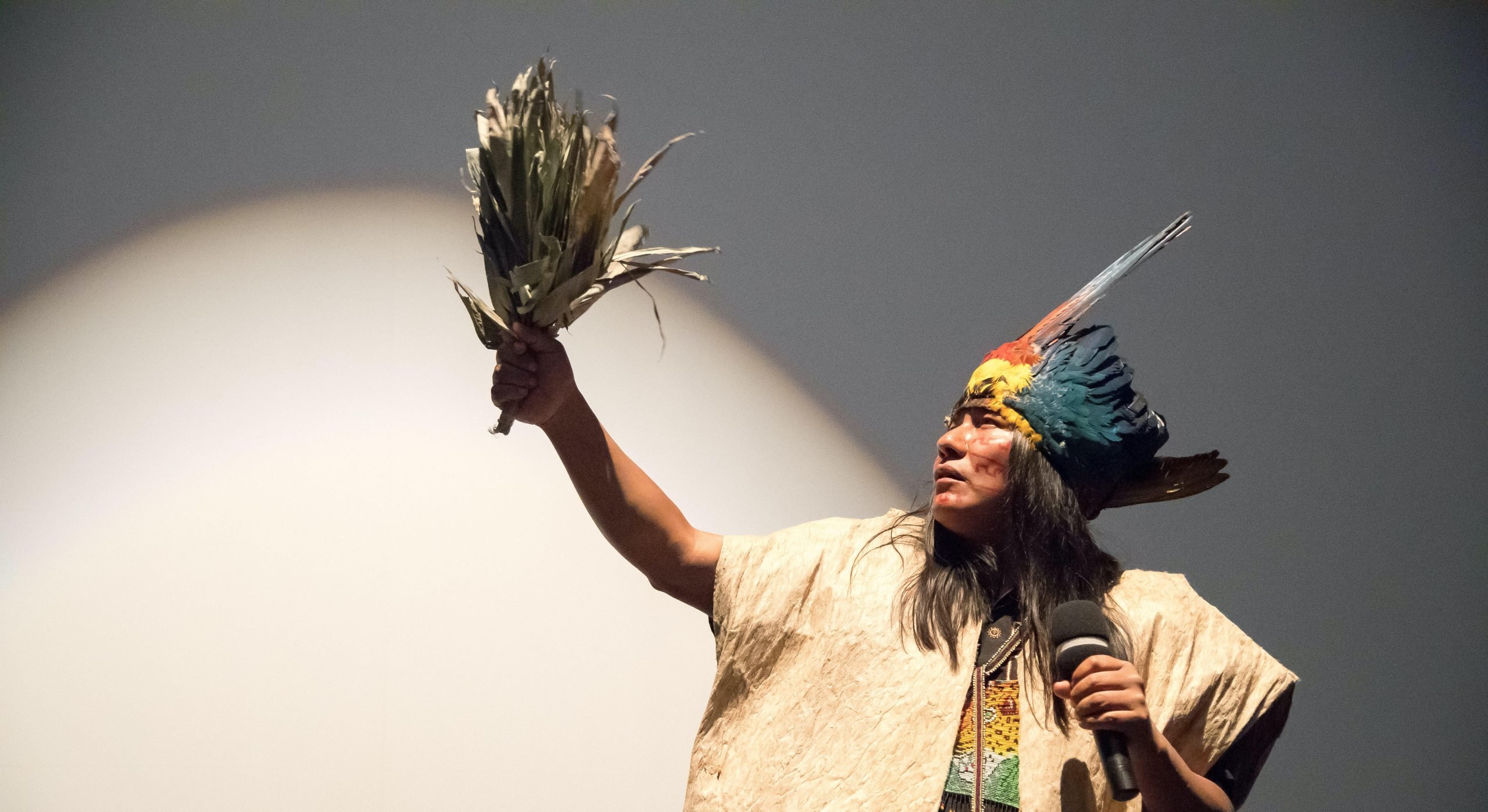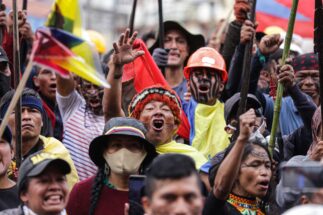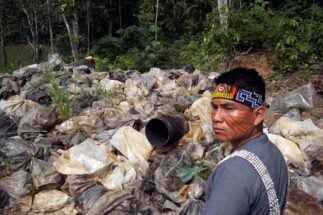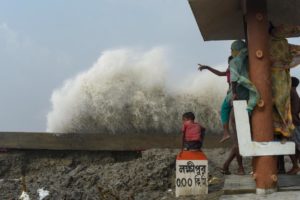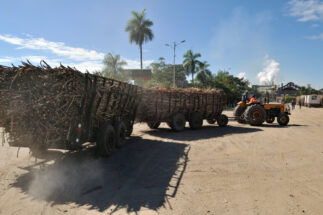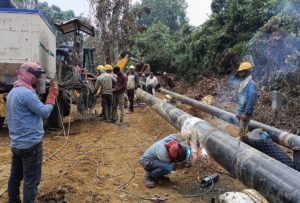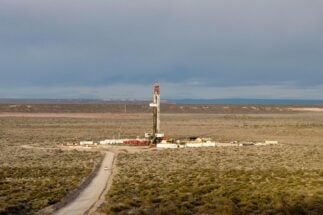“We saw that they were coming and we knew what they were going to do,” said Indigenous leader Manari Ushigua, recalling a distant dream in which he saw his community defend itself against outsiders who came to their forests in search of oil.
A traditional healer and political leader of the Sápara people of the Ecuadorian Amazon, Manari told of how other members in his community described having the same dream. What they saw would later come true.
A vanishing people
The Sápara are an Indigenous people native to the Amazon that once occupied some 12 million hectares of the rainforest across Ecuador and Peru. The less than 600 remaining Sápara now live on just 360,000 hectares of their ancestral land in the Ecuadorian Amazon.
In November 2011, Ecuador’s Ministry of Energy and Non-Renewable Resources presented a new land register detailing oil interests, which outlined 21 fields in the Ecuadorian Amazon covering a total area of 3.6 million hectares. This formed the basis for the Eleventh Round oil auction, a series of tenders for oil exploration launched by the government the following year.
In 2014, the Ecuadorian Ministry of Hydrocarbons announced the award of two of these fields, blocks 79 and 83, to Andes Petroleum, a consortium made up by the China National Petroleum Company and Sinopec, two Chinese state-owned oil firms. Contracts were signed in 2016. Both blocks overlap with land occupied by Sápara communities, and would potentially impact almost 190,000 hectares of Sápara land, equivalent to 52% of their territory.
A 2016 book on the struggles of the Sápara detailed how their people once occupied an estimated 12 million hectares across the entire Amazon rainforest, of which 4.7 million hectares – an area equivalent to the Brazilian state of Rio de Janeiro – were in the Ecuadorian Amazon. Today, the Sápara live on some 360,000 hectares of the Ecuadorian Amazon.
As their territory has shrunk, so too has their population, and with it their culture. In the 19th century, it was estimated that there were 20,000 speakers of the Sápara language. Today, of the less than 600 remaining Sápara people, fewer than 10 speak the ancestral tongue.
With the population decimated and at risk of disappearing, the Sápara’s oral traditions and cultural manifestations were recognised by UNESCO in 2001 as Intangible Cultural Heritage of Humanity – a designation aimed at protecting heritage around the world of outstanding universal value. Included in this is the Sáparas’ interpretation of dreams, a spiritual practice used to guide decision-making and read warnings of the threats to their very existence.
Amid these dangers, the Sápara have shown determination to share their stories with a global audience. Defending their territory against oil extraction, and against new challenges linked to renewable energies, their communities have launched a range of campaigns and projects to raise awareness of their struggles and to promote their culture – and save it from disappearing.
Opposition to extraction
Sápara leaders began to express their opposition to oil activities ahead of the opening of the Eleventh Round oil auction, and encountered hostility soon after. In early 2013, the 13-year-old son of Alcides Ushigua, at that time the president of the Sápara nation, was murdered, only a week after the Sápara people received threats for opposing extraction at a local assembly, a meeting at which community members vote on important decisions. Even the then-president of Ecuador, Rafael Correa, poured scorn on their cause, labelling those opposed to oil drilling in the Amazon as “childish environmentalists” on national television.
The Sápara have since led national and international campaigns to raise awareness of oil drilling plans and their calls to abandon them. Leaders such as Manari Ushigua have taken their message to events such as the People’s Climate March in New York in 2014, and Indigenous Rising in Washington, DC in 2017, where they met the actor Leonardo Di Caprio.
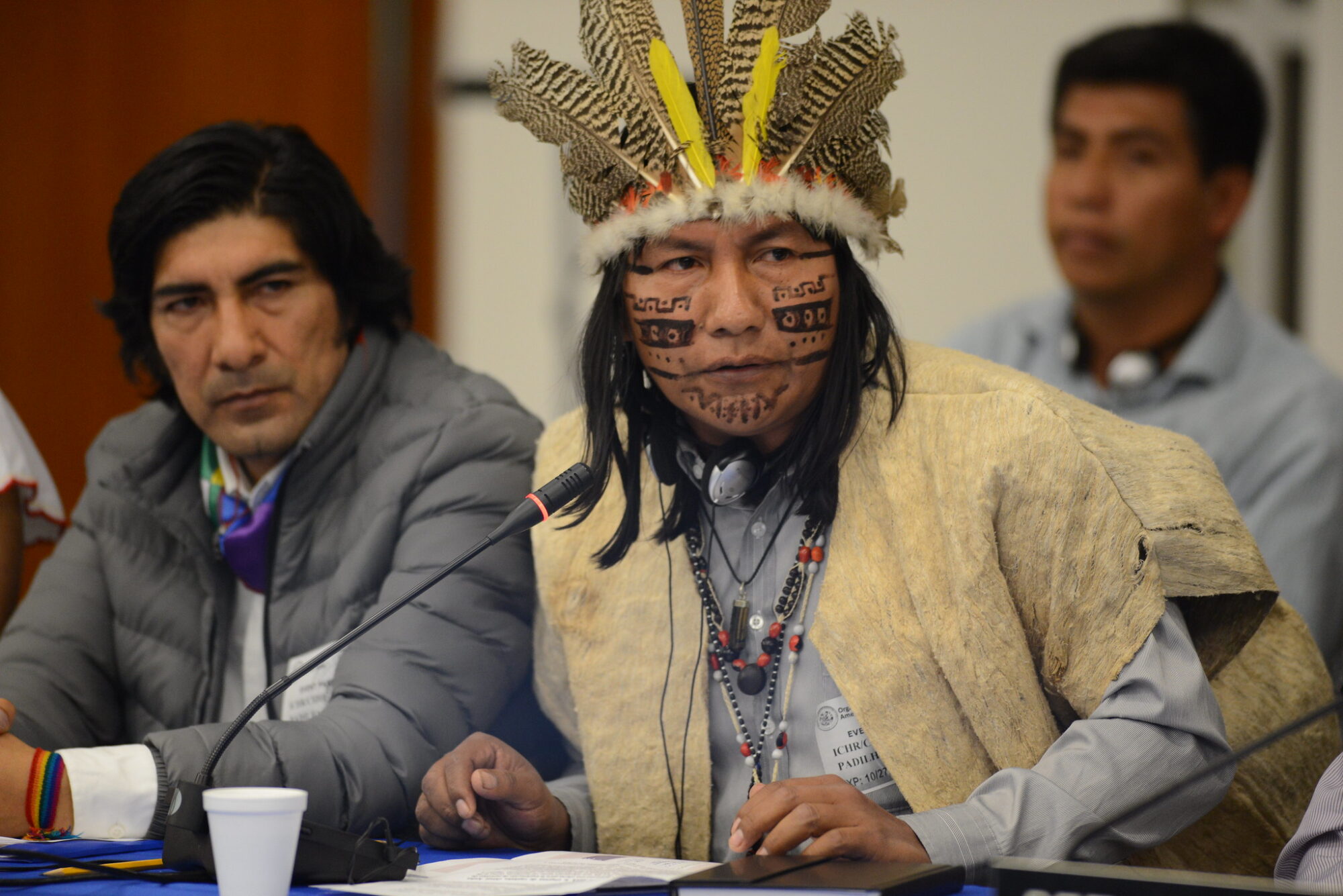
“When Andes Petroleum began to make a nuisance of itself, we stood up strongly,” Auneka Ushigua, the niece of Manari, told Diálogo Chino. “My uncle travelled to other countries and we delivered the message from our people.”
Having witnessed the experiences of communities in the north of the Ecuadorian Amazon, a region which suffered impacts from operations by Chevron-Texaco and other domestic and international oil companies, the Sápara were determined to avoid a repeat of this story. “In the north, there are companies that are extracting all the wells, but the communities don’t see any of the benefits,” said Manari.
The Sápara have also denounced a lack of prior consultation on oil projects on their land, something which has caused divisions among communities. A Sápara representative who signed an agreement with the state and the Chinese consortium during negotiations was described by Manari as “illegitimate” and “an ally of the government”.
When Andes Petroleum began to make a nuisance of itself, we stood up strongly
After several years of sustained pressure and resistance, the Sápara’s efforts brought success. In 2019, Andes Petroleum asked the Ecuadorian state to declare a force majeure that would allow them to withdraw from the project in block 79, owing to community opposition. No decision was issued relating to block 83. Contracts were suspended in 2019, and the company still has no presence in the territory.
Mario Melo, a lawyer with the Pachamama Foundation and dean of the Faculty of Jurisprudence at the Pontifical Catholic University of Ecuador, explained that this suspension is, however, “a temporary measure” as the contracts are still in force, but not being executed. The Sápara continue to demand the cancellation of these contracts.
Diálogo Chino approached Andes Petroleum for comment on the status of the projects at blocks 79 and 83, but at the time of publication no response had been received.
Visions of balsa
Manari told Diálogo Chino of another dream, which came to him in 2019. “Something very strong was coming, but it wasn’t going to work,” he said. As global efforts to meet renewable energy targets increase, there has been a rise in demand for Ecuadorian balsa, a lightweight wood used to produce the blades of wind turbines. Notable demand has come from China, the country with the largest installed wind capacity, and home to several companies that are among the world’s most important producers and exporters of wind power equipment.
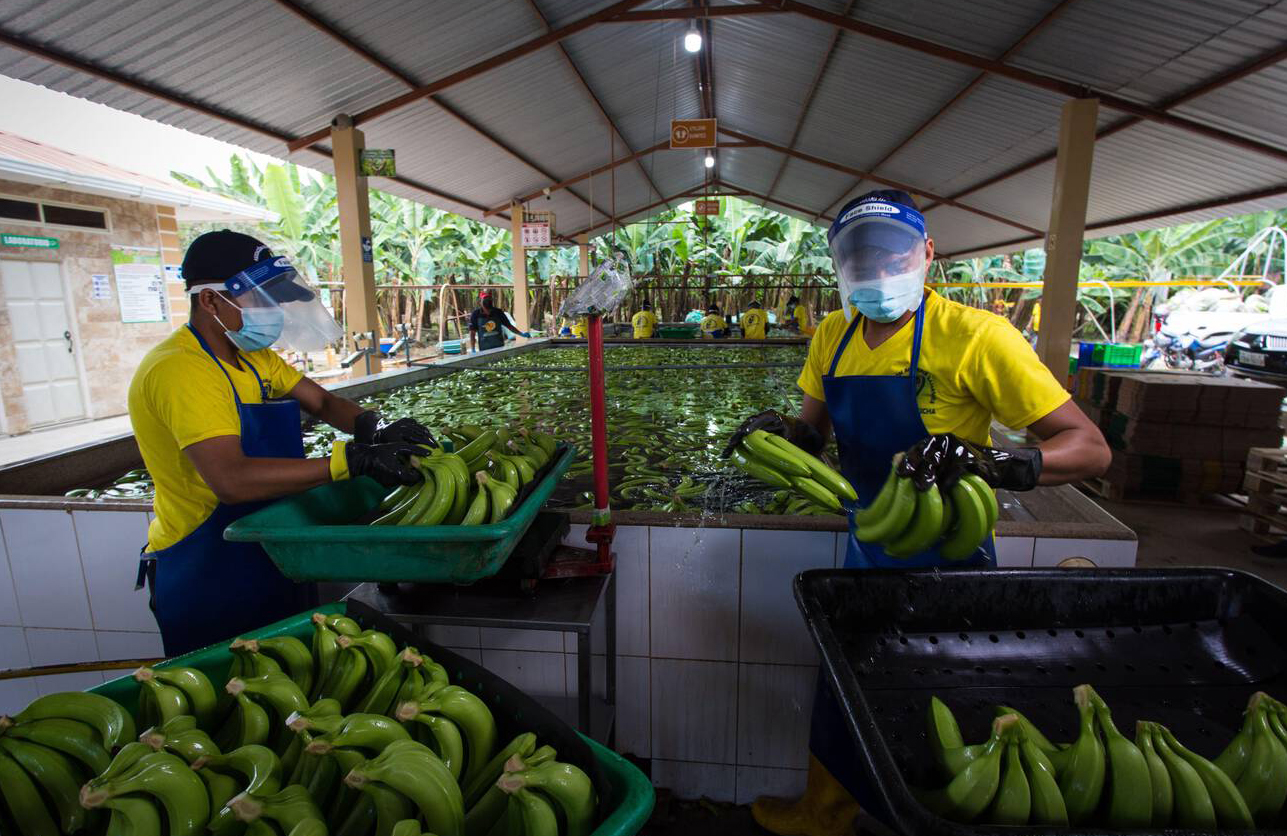
Ecuador is the world’s largest producer of balsa wood, but the growth in demand has given rise to increased illegal extraction by local groups encouraged by an expanding, lucrative market. According to data provided to Diálogo Chino by the National Environmental Protection Police Unit, 6,845 cubic metres of illegal balsa were seized in 2020. This represented an 81% increase on the figure recorded in 2019. In 2020, Pastaza, the Amazonian province in which the Sápara’s lands are located, saw the third-highest number of balsa wood seizures of all Ecuadorian provinces.
Auneka Ushigua recalled that in 2020 the Sápara community of Llanchamacocha organised against extraction. They created Kaunu (a Sápara word meaning “snakes”), a group dedicated to guarding the entrances to their area.
That same year, Auneka formed Yarishaya Itiumu (Women in Bloom), a Sápara collective dedicated to promoting women’s empowerment, and highlighting their role in the defence of Indigenous Peoples and nationalities. “As women from the territory, we will not allow outsiders to harm us,” she said. The group was created in response to their previous experiences with attempts to carry out extractive activities in the territory, and looks to promote alternative economic options to oil or wood extraction.
Alongside other campaigns launched to highlight what was happening to Llanchamacocha, these efforts had by late 2020 helped to deter illegal balsa wood loggers and companies from entering the community. But Manari said that he continued to find evidence of extraction, including 5,000 balsa trees found cut down upstream in late 2020.
As women from the territory, we will not allow outsiders to harm us
However, Christian Riofrío, executive director of the Ecuadorian Association of the Forestry and Timber Industry (AIMA), told Diálogo Chino that “there is nothing more false” than the accusations that balsa companies entered the Amazon in 2019 and 2020 and caused deforestation. “The Amazonian native and primary forest was not entered, but rather [wood was] extracted from where there had already been some disruptive event,” he added.
The formal balsa sector experienced a boom in 2020, with total exports valued at US$570 million, according to data provided to Diálogo Chino by AIMA. “We want to justify the use of this material, which is the most sustainable for wind turbines,” claimed Riofrío.
Beyond its life cycle and the conditions in which it grows, this tree has a special meaning for the Sápara. “The balsa is medicine for us,” said Auneka. According to their beliefs, these trees balance life in the forest: if they are cut down, it is said to have an impact on people, wildlife and ecosystems.
Positive tourism
While the Sápara’s dreams alerted them to the arrival of threats from extraction, they also guided them towards ways of combating such activities.

In 2011, the Naku project was born – a community-owned and operated eco-tourism centre that looks to promote and preserve Sápara culture. The idea for this project, Manari Ushigua said, came about in a dream. With their home at risk from oil companies, the communities took it as a call from the spirits to share their wisdom with the world.
Naku, a Sápara word meaning “jungle”, focuses on spiritual tourism. From the moment visitors disembark the small plane from bigger cities – the only way to reach Sápara territory – they embark on a journey of “transformation and healing”, staying in the community’s huts and learning about the peoples’ worldview. The income from these activities goes towards a common fund to finance the Sápara’s education and health.
In 2013, Naku officially began to welcome tourists. Perhaps their most noteworthy visitor so far is American actor Channing Tatum, who was said to be fascinated by his 2014 visit and decided to contribute to the project. Manari later travelled with Tatum to Los Angeles to raise funds, efforts that helped the project to build its “healing centre” and enabled other areas of Naku to receive visitors, and to continue promoting spiritual tourism.
Virtual dreams
With the arrival of the Covid-19 pandemic, dreams moved to the virtual world. Naku became a space of comfort and for the exchange of experiences, one which continues to function.
With his painted face, colourful plume and traditional dress, Manari stands in front of his computer to conduct his virtual ceremonies. On the other side, hundreds of people, connected from more than 30 countries, watch him.
When you enter the dream world, you see that everything you do or say has an impact
Since the pandemic began, this Sápara leader has reached more than 900 students through Dream World, an online platform offering courses based around Sápara dreaming practices. Over four weeks, attendees learn to decipher the meaning of what they observe in their sleep, to distinguish between different kinds of dreams and teaching methods to help remember what they saw. “When you enter that world, you see that everything you do or say has an impact,” says Manari.
On his Instagram account, Manari does live broadcasts and ceremonies from the jungle for his more than 49,000 followers. The Dream World programme continues to grow and now offers year-long courses. In the meantime, the Naku project is being promoted by Manari and the Sápara as an economic model which can help the communities avoid dependence on extractive activities.
More projects
Building on their previous experiences of sharing their culture with the world, the Sápara communities are currently working on Shimaka (meaning “living wisdom”), a project that plans to create a curriculum to disseminate their knowledge in schools and universities in other countries. They plan to present the programme in 2023 in Quito, New York and Rome.
Sápara youth are also playing an active role in the dissemination of their culture. Sani Montahuano, 25, is the co-founder of Tawna, an artistic project focusing on “cinema from and for the territory.” This project was born out of her brother Yanda’s dream.
“Other people would come to film us and take all that material with them and we would never see it,” Montahuano told Diálogo Chino. The siblings create documentaries, videos and photography that highlight the Sapara’s efforts to protect the Amazon territory from extractive activities. The premiere for each takes place in their territories.
Montahuano is striving to learn her ancestral language. Her grandparents spoke it, but her mother no longer does. Now she tries to do so through songs. “It’s very important to go back to that and teach those who don’t know, so that they can help us defend the land,” she says.
Reflecting on the various projects and campaigns that his people have launched in recent years, Manari Ushigua continues to dream of an Amazon without deforestation or oil extraction. “We made the decision to share this knowledge because the Sápara world was at risk of disappearing. If someone else learns our wisdom, our roots will be stronger.”
